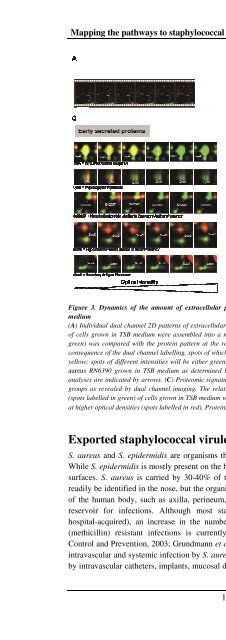The Staphylococcus aureus secretome - TI Pharma
The Staphylococcus aureus secretome - TI Pharma
The Staphylococcus aureus secretome - TI Pharma
Create successful ePaper yourself
Turn your PDF publications into a flip-book with our unique Google optimized e-Paper software.
Mapping the pathways to staphylococcal pathogenesis by comparative secretomics<br />
Figure 3. Dynamics of the amount of extracellular proteins during growth of S. <strong>aureus</strong> RN6390 in TSB<br />
medium<br />
(A) Individual dual channel 2D patterns of extracellular proteins during the different phases of the growth curve<br />
of cells grown in TSB medium were assembled into a movie. <strong>The</strong> protein pattern at an OD 540 of 1 (labelled in<br />
green) was compared with the protein pattern at the respective higher optical densities (labelled in red). As a<br />
consequence of the dual channel labelling, spots of which the intensities do not differ in the compared gels will be<br />
yellow; spots of different intensities will be either green or red (Bernhardt et al., 1999). (B) Growth curve of S.<br />
<strong>aureus</strong> RN6390 grown in TSB medium as determined by OD 540 readings. <strong>The</strong> sampling points for proteomics<br />
analyses are indicated by arrows. (C) Proteomic signatures of selected proteins representing different regulatory<br />
groups as revealed by dual channel imaging. <strong>The</strong> relative amounts of the respective proteins at an OD 540 of 1<br />
(spots labelled in green) of cells grown in TSB medium were compared with the relative amounts of these proteins<br />
at higher optical densities (spots labelled in red). Proteins were stained with Sypro Ruby ® .<br />
Exported staphylococcal virulence factors<br />
S. <strong>aureus</strong> and S. epidermidis are organisms that occur naturally in and on the human body.<br />
While S. epidermidis is mostly present on the human skin, S. <strong>aureus</strong> can be found on mucosal<br />
surfaces. S. <strong>aureus</strong> is carried by 30-40% of the population (Peacock et al., 2001) and can<br />
readily be identified in the nose, but the organism can also be detected in other moist regions<br />
of the human body, such as axilla, perineum, vagina and rectum, thereby forming a major<br />
reservoir for infections. Although most staphylococcal infections are nosocomial (i.e.<br />
hospital-acquired), an increase in the number of cases of community-acquired antibiotic<br />
(methicillin) resistant infections is currently observed world-wide (Centers for Disease<br />
Control and Prevention, 2003; Grundmann et al., 2002; Vandenesch et al., 2003). <strong>The</strong> risk of<br />
intravascular and systemic infection by S. <strong>aureus</strong> rises when the epithelial barrier is disrupted<br />
by intravascular catheters, implants, mucosal damage or trauma. Interestingly, after infection,<br />
19













